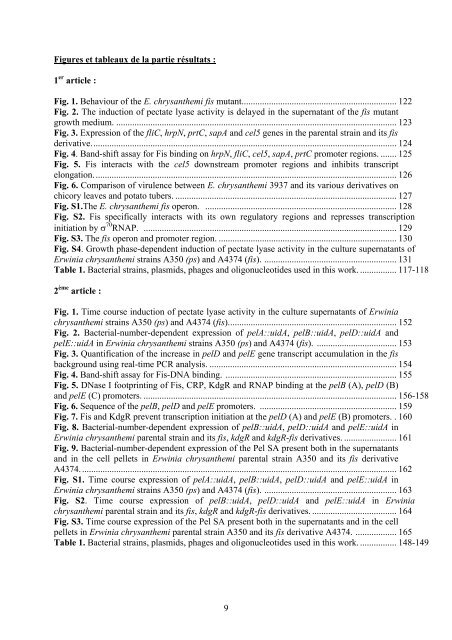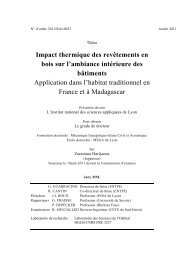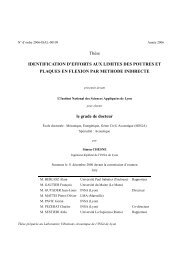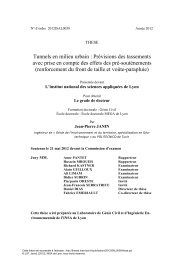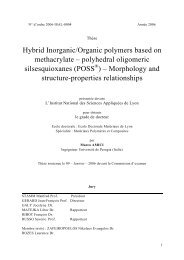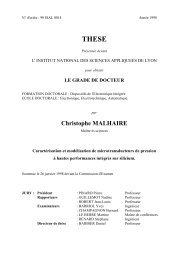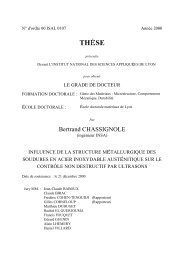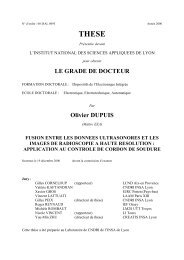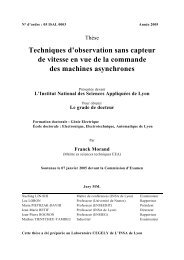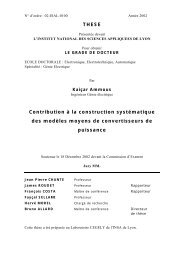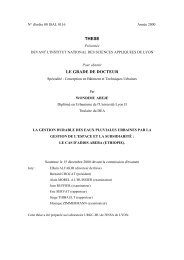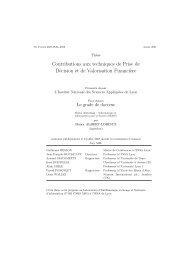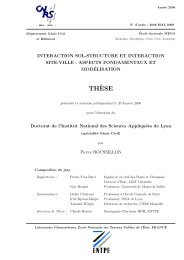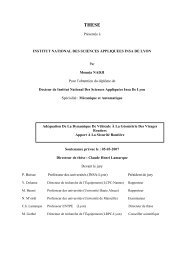Rôle de la protéine associée au nucléoïde Fis dans le contrôle de la ...
Rôle de la protéine associée au nucléoïde Fis dans le contrôle de la ...
Rôle de la protéine associée au nucléoïde Fis dans le contrôle de la ...
Create successful ePaper yourself
Turn your PDF publications into a flip-book with our unique Google optimized e-Paper software.
Figures et tab<strong>le</strong><strong>au</strong>x <strong>de</strong> <strong>la</strong> partie résultats :<br />
1 er artic<strong>le</strong> :<br />
Fig. 1. Behaviour of the E. chrysanthemi fis mutant.................................................................... 122<br />
Fig. 2. The induction of pectate lyase activity is <strong>de</strong><strong>la</strong>yed in the supernatant of the fis mutant<br />
growth medium. ........................................................................................................................... 123<br />
Fig. 3. Expression of the fliC, hrpN, prtC, sapA and cel5 genes in the parental strain and its fis<br />
<strong>de</strong>rivative...................................................................................................................................... 124<br />
Fig. 4. Band-shift assay for <strong>Fis</strong> binding on hrpN, fliC, cel5, sapA, prtC promoter regions. ....... 125<br />
Fig. 5. <strong>Fis</strong> interacts with the cel5 downstream promoter regions and inhibits transcript<br />
elongation..................................................................................................................................... 126<br />
Fig. 6. Comparison of viru<strong>le</strong>nce between E. chrysanthemi 3937 and its various <strong>de</strong>rivatives on<br />
chicory <strong>le</strong>aves and potato tubers. ................................................................................................. 127<br />
Fig. S1.The E. chrysanthemi fis operon. .................................................................................... 128<br />
Fig. S2. <strong>Fis</strong> specifically interacts with its own regu<strong>la</strong>tory regions and represses transcription<br />
initiation by σ 70 RNAP. ............................................................................................................... 129<br />
Fig. S3. The fis operon and promoter region. .............................................................................. 130<br />
Fig. S4. Growth phase-<strong>de</strong>pen<strong>de</strong>nt induction of pectate lyase activity in the culture supernatants of<br />
Erwinia chrysanthemi strains A350 (ps) and A4374 (fis). .......................................................... 131<br />
Tab<strong>le</strong> 1. Bacterial strains, p<strong>la</strong>smids, phages and oligonuc<strong>le</strong>oti<strong>de</strong>s used in this work. ................ 117-118<br />
2 ème artic<strong>le</strong> :<br />
Fig. 1. Time course induction of pectate lyase activity in the culture supernatants of Erwinia<br />
chrysanthemi strains A350 (ps) and A4374 (fis).......................................................................... 152<br />
Fig. 2. Bacterial-number-<strong>de</strong>pen<strong>de</strong>nt expression of pelA::uidA, pelB::uidA, pelD::uidA and<br />
pelE::uidA in Erwinia chrysanthemi strains A350 (ps) and A4374 (fis). ................................... 153<br />
Fig. 3. Quantification of the increase in pelD and pelE gene transcript accumu<strong>la</strong>tion in the fis<br />
background using real-time PCR analysis. .................................................................................. 154<br />
Fig. 4. Band-shift assay for <strong>Fis</strong>-DNA binding. ........................................................................... 155<br />
Fig. 5. DNase I footprinting of <strong>Fis</strong>, CRP, KdgR and RNAP binding at the pelB (A), pelD (B)<br />
and pelE (C) promoters. ............................................................................................................... 156-158<br />
Fig. 6. Sequence of the pelB, pelD and pelE promoters. ............................................................ 159<br />
Fig. 7. <strong>Fis</strong> and KdgR prevent transcription initiation at the pelD (A) and pelE (B) promoters. . 160<br />
Fig. 8. Bacterial-number-<strong>de</strong>pen<strong>de</strong>nt expression of pelB::uidA, pelD::uidA and pelE::uidA in<br />
Erwinia chrysanthemi parental strain and its fis, kdgR and kdgR-fis <strong>de</strong>rivatives. ....................... 161<br />
Fig. 9. Bacterial-number-<strong>de</strong>pen<strong>de</strong>nt expression of the Pel SA present both in the supernatants<br />
and in the cell pel<strong>le</strong>ts in Erwinia chrysanthemi parental strain A350 and its fis <strong>de</strong>rivative<br />
A4374. .......................................................................................................................................... 162<br />
Fig. S1. Time course expression of pelA::uidA, pelB::uidA, pelD::uidA and pelE::uidA in<br />
Erwinia chrysanthemi strains A350 (ps) and A4374 (fis). .......................................................... 163<br />
Fig. S2. Time course expression of pelB::uidA, pelD::uidA and pelE::uidA in Erwinia<br />
chrysanthemi parental strain and its fis, kdgR and kdgR-fis <strong>de</strong>rivatives. ..................................... 164<br />
Fig. S3. Time course expression of the Pel SA present both in the supernatants and in the cell<br />
pel<strong>le</strong>ts in Erwinia chrysanthemi parental strain A350 and its fis <strong>de</strong>rivative A4374. .................. 165<br />
Tab<strong>le</strong> 1. Bacterial strains, p<strong>la</strong>smids, phages and oligonuc<strong>le</strong>oti<strong>de</strong>s used in this work. ................ 148-149<br />
9


